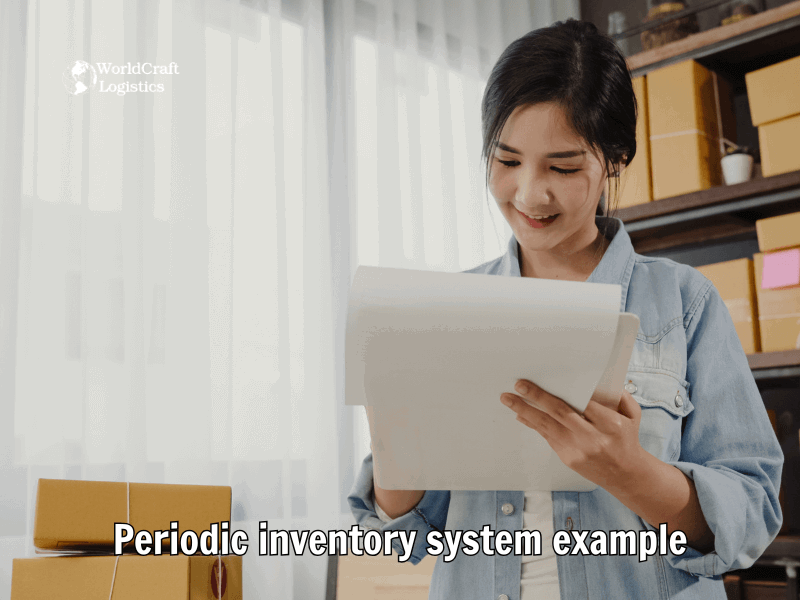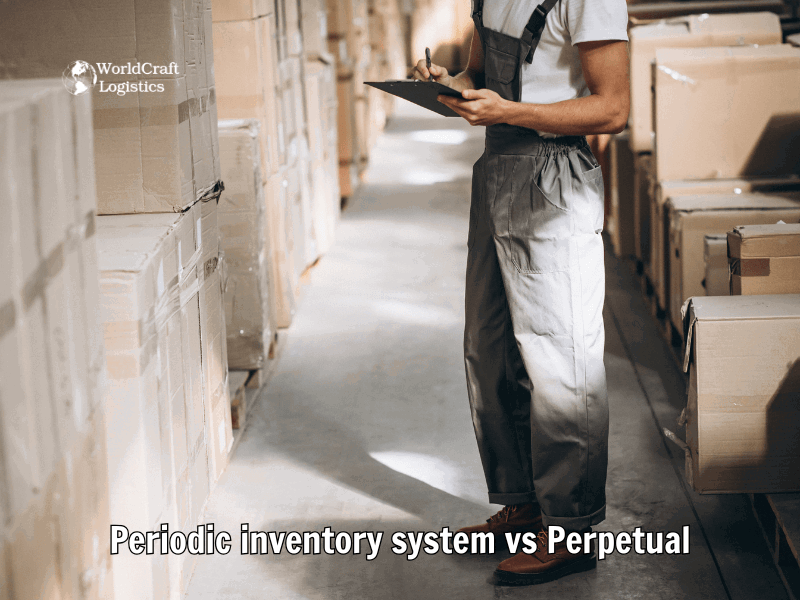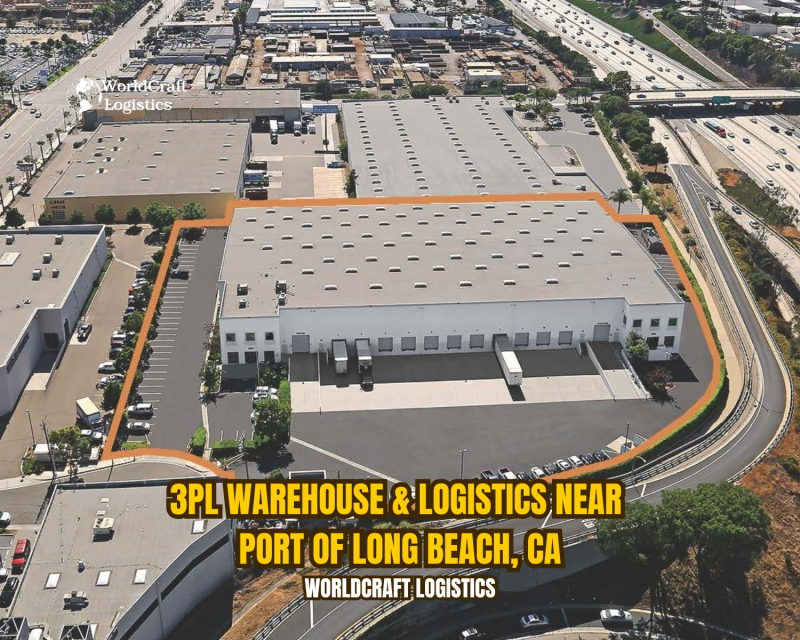
Starting June 1st, 2023 Our warehouse fee will be $0.65/cubic foot per month
In effort to lower the warehouse storage fee during inflation, we have went narrow aisle racking.This construction took us four months but the project is finally completed. With narrow aisle racking, we are able to drop storage by 24%.We as partners will go through this inflation together.
12/24/2024
The periodic inventory system is an effective method for managing inventory that offers simplicity and cost-efficiency, especially for small businesses. By conducting physical inventory counts at regular intervals, businesses can easily track inventory levels and determine the cost of goods sold. This system minimizes the need for continuous updates, making it a popular choice for companies looking to reduce overhead costs. Worldcraft Logistics invites you to read the article we shared to learn more about how this method can benefit your business.

The periodic inventory system is an inventory valuation method used for financial reporting in which a physical count of inventory is conducted at regular intervals, such as monthly, quarterly, or annually. This accounting method involves determining the beginning inventory at the start of a period, adding any new inventory purchases made during the period, and then subtracting the ending inventory at the end of the period to calculate the cost of goods sold (COGS).

In a periodic inventory system, businesses do not maintain real-time records of sales or inventory changes. Instead, inventory updates are logged in a separate purchases account throughout a defined period, such as a month, quarter, or year.
At the end of the period, a physical inventory count is conducted to calculate the ending inventory and determine the cost of goods sold (COGS). This approach simplifies inventory tracking but lacks real-time accuracy.
The periodic inventory system formula is used to calculate the Cost of Goods Sold (COGS) and is as follows:
COGS = Beginning Inventory + Purchases - Ending Inventory
This formula provides a clear method for determining the value of inventory sold during a specific period.
Components of the Formula:
The periodic inventory system formula simplifies inventory management for businesses by providing a straightforward way to calculate COGS. Through examples, it is clear that the formula accurately tracks inventory usage over any defined accounting period.

Here are three periodic inventory system examples to demonstrate how different businesses can apply the periodic inventory method:
Calculation of Cost of Goods Sold (COGS):
COGS = Beginning Inventory + Purchases - Ending Inventory
COGS = $8,000 + $4,500 - $3,500 = $9,000
➡️ Conclusion: The grocery store calculates that $9,000 worth of inventory was sold during the month. The periodic inventory system is sufficient because the grocery store doesn’t need real-time tracking of inventory and can focus on overall monthly inventory updates.
Calculation of Cost of Goods Sold (COGS):
COGS = Beginning Inventory + Purchases - Ending Inventory
COGS = $20,000 + $12,000 - $15,000 = $17,000
➡️ Conclusion: In this case, the clothing boutique sold $17,000 worth of inventory during the month. Since the business focuses on high-value, low-volume products, the periodic system is a cost-effective method to track sales without the need for constant inventory updates.
Calculation of Cost of Goods Sold (COGS):
COGS = Beginning Inventory + Purchases - Ending Inventory
COGS = $50,000 + $25,000 - $35,000 = $40,000
➡️ Conclusion: For this electronics store, the total COGS for the quarter is $40,000, which represents the inventory sold during the period. Despite the higher inventory value and complex items, the periodic inventory system is a simple and effective method for this type of business, especially as it’s not required to track sales and purchases in real-time.
Summary:
✔️ Grocery Store: $9,000 COGS
✔️ Clothing Boutique: $17,000 COGS
✔️ Electronics Store: $40,000 COGS
Each example highlights how the periodic inventory system works across different industries, providing a clear way to track and manage inventory without the need for real-time updates.

The periodic inventory system offers a straightforward way to manage inventory, but it comes with its own set of advantages and limitations. Here's a fresh perspective on its merits and challenges:
Cost-Effectiveness: Unlike perpetual systems that require sophisticated software and hardware, a periodic system is simpler and cheaper to implement. It’s ideal for small businesses or startups with limited budgets.
Ease of Use: The periodic system involves straightforward accounting methods, making it accessible even for businesses without advanced financial expertise. This simplicity reduces the learning curve for employees.
Focus on Period-End Efficiency: Businesses can prioritize day-to-day operations without constantly monitoring inventory. Inventory management efforts are concentrated during the physical count at the end of the period.
Flexibility for Low-Turnover Inventory: For businesses with slow-moving inventory, such as art galleries or furniture retailers, the periodic system is sufficient and avoids the unnecessary complexity of continuous tracking.
Lack of Real-Time Insights: The most significant disadvantage is the absence of real-time inventory data. This can lead to stockouts, overstocking, or delays in identifying discrepancies during the period.
Inaccuracy Risks: Relying on periodic physical counts can result in human errors, especially in large-scale operations. These inaccuracies can impact financial reporting and decision-making.
Incompatibility with Fast-Paced Businesses: Industries with high inventory turnover, such as retail or e-commerce, may struggle with delayed updates, making the system unsuitable for dynamic environments.
Labor-Intensive Physical Counts: Conducting physical inventory counts requires significant time and effort, often disrupting normal business operations. This can be particularly challenging for businesses with large inventories.
Combine Systems Strategically: Use a periodic system for slow-moving or low-value items and a perpetual system for fast-moving or high-value items. This hybrid approach balances cost-effectiveness and accuracy.
Leverage Technology: While the periodic system is manual, adopting affordable tools such as barcode scanners or mobile inventory apps can streamline physical counts and reduce errors.
Implement Frequent Mini-Counts: Instead of waiting for the end of the period, perform spot checks or mini-counts on critical inventory categories to identify discrepancies early.
This expert analysis provides a unique take on the advantages and drawbacks of a periodic inventory system, emphasizing creativity and practical solutions to minimize challenges.

A periodic inventory system is particularly beneficial for small businesses with a limited number of products (SKUs) and operations that are not focused on rapid scaling. If a business is looking for simplicity rather than real-time tracking, this system provides a cost-effective solution. It is especially useful for businesses that don’t need to manage a high volume of sales or extensive product lines.
The appeal of the periodic inventory system lies in its low cost of implementation and ease of operation. There’s no requirement for complex technology or software, which makes it an attractive choice for small businesses. Moreover, the system is easy to manage, even when you have high employee turnover or limited time to dedicate to inventory tracking. For instance, seasonal workers can quickly count stock during the physical inventory check, unlike in a perpetual system, where employees must be trained to use electronic scanners and input data continuously.
Additionally, a periodic system works well for businesses that have a firm grip on their supply chain processes and inventory flow. If you sell a small number of products and maintain close oversight of your stock, the periodic system can be a practical choice. However, if you require more precision in tracking inventory and resolving discrepancies, this method may become problematic as your operation grows.
As Milner puts it, periodic systems are ideal for small businesses that maintain a simple approach to inventory. These businesses often don’t need to establish complex relationships between raw materials and finished goods, making periodic checks sufficient. A classic example of this is a food bank, which regularly conducts physical counts to determine inventory levels.
In summary, the periodic inventory system is best suited for businesses that prioritize simplicity, cost-efficiency, and ease of implementation. However, as businesses scale or require more detailed tracking, transitioning to a perpetual system may be a better long-term solution.
Both periodic and perpetual inventory systems are widely used for tracking inventory, but they operate in very different ways. Each has its advantages and drawbacks depending on the size, needs, and nature of the business. Below is a comparison of the two systems to help determine which might be better suited to your business needs.
| Feature | Periodic Inventory System | Perpetual Inventory System |
|---|---|---|
| Definition | Inventory updates occur at specific intervals (e.g., monthly, yearly). | Inventory updates happen in real-time after every transaction. |
| Tracking Method | Relies on physical inventory counts to update records. | Uses technology (e.g., barcodes, RFID) to automatically track inventory. |
| Real-Time Data | Does not provide real-time inventory levels. | Provides real-time and accurate inventory levels. |
| Cost Updates | Costs of goods sold (COGS) are calculated after physical counts. | COGS is updated continuously with each sale or purchase. |
| Technology Requirement | Minimal technology required, can be managed manually. | Requires advanced inventory management systems and software. |
| Ease of Implementation | Easier and more affordable to implement for small businesses. | More complex and costly to set up and maintain. |
| Accuracy | Prone to errors due to reliance on periodic counts. | High accuracy due to real-time updates and automated tracking. |
| Suitable For | Small businesses or those with low inventory turnover. | Businesses with high inventory turnover or large product catalogs. |
| Inventory Valuation | Updates inventory valuation at the end of the accounting period. | Continuously updates inventory valuation. |
| Example Scenarios | Retail stores conducting annual stock counts. | Large-scale warehouses or e-commerce businesses. |
| Advantages | Cost-effective; simple process. | Real-time data; improved decision-making; reduced stockouts. |
| Disadvantages | Lacks real-time accuracy; higher risk of stock discrepancies. | Higher upfront costs; requires training and maintenance. |
Periodic Inventory System is ideal for businesses with low product volumes, limited budgets, and those who don’t require immediate updates. It’s perfect for small retailers, restaurants, and businesses where the inventory turnover rate is low, and simplicity is key.
Perpetual Inventory System is best for businesses with large inventories, high turnover, or those dealing with high-value items. It is suitable for companies that need to have detailed, real-time data on their stock, such as e-commerce retailers, electronics stores, and wholesalers.

In conclusion, the decision between a periodic and perpetual inventory system largely depends on the size of your business, the volume of transactions, and your need for real-time data accuracy. While a periodic system is cost-effective and easy to implement, a perpetual system offers greater control and insight, albeit at a higher cost.
Yes, some businesses may choose to combine both systems, using a perpetual inventory system for high-value or fast-moving items and a periodic system for slower-moving stock. This hybrid approach helps businesses manage costs and gain real-time data for key inventory.
The frequency of inventory counts depends on the business’s needs. Common intervals include monthly, quarterly, or yearly, with businesses deciding based on how often they want to update their records.
A periodic system may not be ideal for businesses with high turnover or fast-moving inventory, as it lacks real-time updates. In these cases, a perpetual inventory system would be more beneficial to maintain accurate stock levels and manage inventory efficiently.
While a periodic system can work for e-commerce businesses with lower transaction volumes, larger or high-volume e-commerce operations often require a perpetual inventory system for better real-time control over stock levels and more precise tracking of goods.
The Periodic Inventory System itself does not dictate whether a business uses LIFO (Last In, First Out) or FIFO (First In, First Out) for inventory valuation. These are methods of cost flow assumptions that determine how the cost of goods sold (COGS) is calculated when using the periodic system.
FIFO (First In, First Out): In FIFO, the assumption is that the oldest inventory items (the first ones purchased) are sold first. This means that the ending inventory consists of the most recently purchased items.
LIFO (Last In, First Out): In LIFO, the assumption is that the most recently purchased items (the last ones acquired) are sold first, leaving the oldest items in inventory.
When using a periodic system, businesses can choose either FIFO, LIFO, or another cost flow method (like weighted average cost) at the end of the accounting period during the physical count to determine the Cost of Goods Sold (COGS) and ending inventory.
The choice between FIFO and LIFO impacts how inventory is valued and can have tax implications, particularly in industries where prices fluctuate frequently.
So, the periodic system itself doesn't enforce FIFO or LIFO; it simply requires a physical count at the end of the period, where any of these cost flow methods can be applied.
In conclusion, the periodic inventory system strikes a balance between simplicity and cost-effectiveness, making it a popular choice for businesses with lower inventory turnover. While it may not provide real-time updates, its ease of use and low overhead costs make it ideal for smaller enterprises. Overall, the periodic system offers an efficient way to manage inventory without the complexity of more advanced tracking methods.
SEO
Digital Marketing/SEO Specialist
Simon Mang is an SEO and Digital Marketing expert at Wordcraft Logistics. With many years of experience in the field of digital marketing, he has shaped and built strategies to effectively promote Wordcraft Logistics' online presence. With a deep understanding of the logistics industry, I have shared more than 500 specialized articles on many different topics.

Warehouse
12/30/2024

Warehouse
06/16/2024

Warehouse
03/03/2024

Warehouse
08/25/2024

Warehouse
02/20/2023